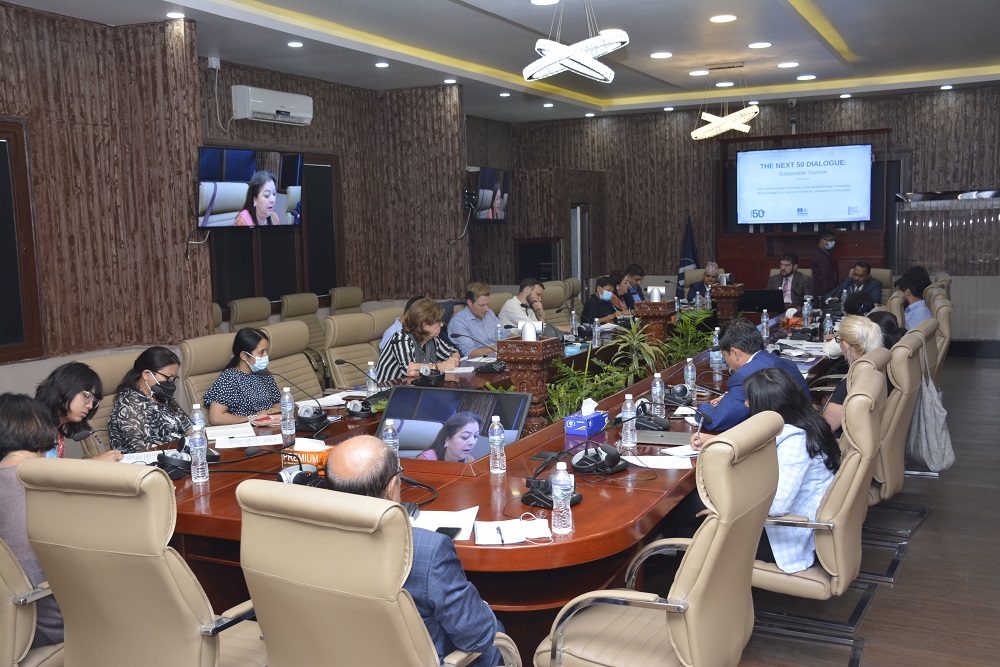KATHMANDU: Experts and stakeholders have stressed developing Sustainable Tourism with a focus on future-oriented conservation of World Heritage Sites and empowerment of indigenous local populations in Nepal.
United Nations Educational, Scientific and Cultural Organization (UNESCO) in collaboration with Institute for Strategic and Social Economic Research (ISSR) organized an interaction as part of its “The Next 50 Dialogue” on the occasion of the 50th anniversary of the adoption of World Heritage Convention, at Pavilion Hall, in Durbar Marg, Kathmandu, on Thursday.
Officials from government and non-government organizations, the private sector, sustainable tourism entrepreneurs and international experts, among others, delved into various aspects of establishing sustainable tourism in the context of Nepal’s unbounded tourism potential, rich and diverse cultural and natural heritage sites and heart-warming communities.
Sophia L. Pandé, UNESCO’s The Next 50 coordinator says, “With the learnings from these dialogues we hope Nepal can leverage our Cultural WHSs with the added weight of our distinctive natural resources to deliver a unique, multi-pronged, inclusive, Sustainable Tourism best practice model.”
On the occasion, UNESCO Coordinator for Cultural and Creative Industry in Nepal Saroj Mahato talked about ongoing attempts to list cultural cities such as Kathmandu, Bhaktapur and Lalitpur, among others, under the UNESCO Creative Cities Network — a network of 240 cities across the globe.
He expressed confidence that doing so would contribute to sustainable tourism, keep art and culture at the heart of development and support local creative industries, communities and people.
Nepal Tourism Board (NTB) Director Mani Raj Lamichhane, acknowledging the potential of sustainable tourism in the country, said various initiatives were being undertaken to inform tourists about World Heritage Sites and other touristic places.
He mentioned that NTB was in the process of expanding QR codes in many tourist destinations to better inform visiting tourists with the aid of technology. He added that NTB had given special attention to empowering local populations that were vulnerable due to mass tourism.
He said Mayor Balendra Shah’s idea of promoting Indra Jatra and other festivals as global festivals were certainly encouraging to boost tourism.
Likewise, President of Hotel Association Nepal (HAN) Shreejana Rana touched upon various initiatives taken by the hotel sector to ensure sustainable and eco-friendly tourism.
“The hotel sector is replacing traditional kitchens with electric ones, using solar panels for power and using biodegradable amenities whenever possible and viable to contribute to sustainable tourism,” she said.
Citing various challenges faced for the same, she also offered various policy recommendations to government officials present at the program. She also sought subsidies and standardization regulations for the hotel industry to make the hotel sector energy efficient.
Various other speakers from various organizations also emphasized long-term strategy and policies to establish sustainable tourism and the role it would play in uplifting local communities besides tourism’s direct benefit to the economy.
Also taking part in the discussion, Gyanin Rai, representing Lumbini Development Trust, rued uncoordinated efforts of international organizations in Lumbini cultural heritage site.
Executive Director of Bridges Between Katherine Demsky pointed out the lack of adequate perspectives and advertisements to promote tourism in Lumbini area.
Chairman of Ace Hotel Yogendra Shakya elucidated various areas of tourism and said culture was dominant aspect of Nepal’s tourism industry. He floated the idea of 12 festivals for 12 months to promote cultural tourism in Nepal.
Shakya added Nepal had been, to a greater extent, able to capitalize on natural heritages but promoting and harnessing gains from cultural tourism remained.
Similarly, Chief of the World Heritage Conservation section of the Department of Archeology Ramesh Raj Paudel said sustainable tourism or just tourism was not a self-standing sector. He added collaborative efforts were required to reach common goals for the same.
He mentioned that various efforts were underway for developing sustainable, climate-friendly tourism. “It ought to be Tourism for Heritage and Heritage for Tourism and we need to take a local approach in every heritage site.”
CEO of Himalayan Climate Initiative Avani Mani Dixit said safety, especially in buildings and designs in mountainous regions, was a matter of concern. He was of the view that Nepal had to work out well in terms of climate-friendly infrastructure in the tourism sector and be proactive in the same.
“Or else, it would send a negative message,” he warned, adding, “We should not wait for disasters to develop resilient infrastructure.”
Chairman of Khabarhub Naresh Shrestha, also the co-host of the interaction, shed light on other aspects and benefits of tourism in the country. Clarifying the common misconception that the business community was only concerned about profits, he said it wasn’t so and the business or private sector could also contribute to sustainability and fostering local communities.
He also pointed out flaws in government regulations and ambitions while promoting tourism and tourism-focused activities.
“The government wants to bring in 2 million tourists but where does it expect that number of tourists to go? The obsession of authorities with numbers doesn’t match if tourists are coming, spending $5 on bed-and-breakfast in Thamel and not staying for more than two days,” he said.
UNESCO Representative to Nepal Michael Croft, at the end of the interaction, said the discussions were really fruitful and expressed his commitment to come up with a sustainable tourism framework for World Heritage Sites.
“The framework would be able to fit in the challenges, guidelines and action for sustainable tourism while simultaneously conserving tangible and intangible heritage in poor-world nations,” he said.
Ever since UNESCO adopted the World Heritage Convention in 1972, it has been working towards linking concepts of nature conservation and the preservation of cultural properties by acknowledging the way people interact with nature, and the fundamental need to preserve the balance between the two.









Comment